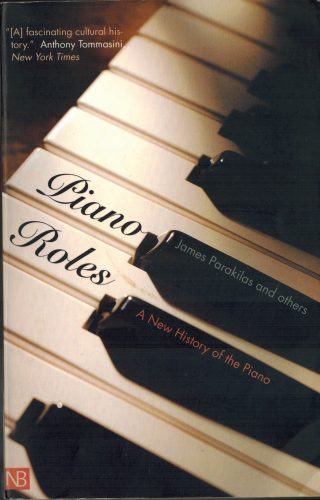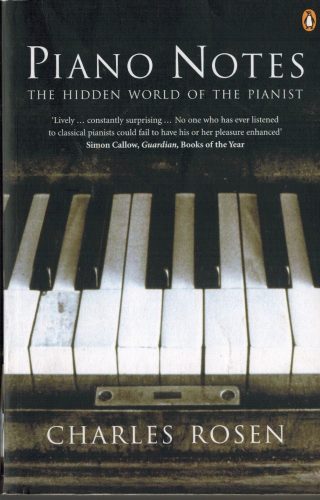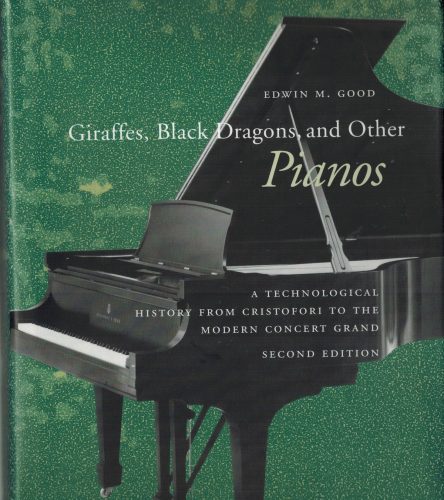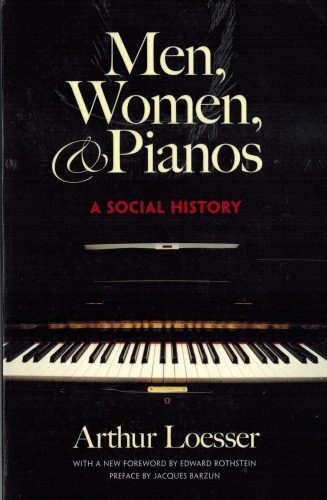As a pianist, it’s tempting on Piano Day to write about playing the piano, rather than the piano itself. So to avoid that temptation, I’m giving a quick guide to my favourite books on the piano. The list isn’t in order of preference—they’re not competing for the same space, they all bring something different to the topic, though also reiterating some of the same themes. See the reference list at the bottom of the page for the full details of each one.
1. Piano Roles, James Parakilas
Although Parakilas is the main named author, the book is the combined work of Parakilas and fourteen others, including big-hitters like Richard Leppert, Judith Tick, Michael Chanan, and Edwin Good who wrote one of the books I mention on this page. It’s not, however, an edited collection of articles—it hangs together beautifully as a whole, which Parakilas attributes to the work of Julie Carlson “who blended the writing of all the contributors together to tell a single story.” Apart from breadth and depth of the chapters on various themes, there is a four-page annotated bibliography of recommendations for further reading at the end.
I’m indebted to one of my former RAD students for (re)alerting me to this book, which she cited in her dissertation on pianos and ballet classes. Indebted, because reading the extracts she’d cited made me want to re-read it. Second time around, I realized that I had completely missed what a rich and wonderful book it is, and how much Parakilas has to say about the role of the piano in ballet and opera rehearsals. This extract from early on in the book gives a taste of the insight Parakilas brings to the topic:

The theme of this cultural history of the piano is that the piano has always exhibited a unique power to act as a cultural go-between, as a medium through which social spheres that stood in opposition to each other could nonetheless nourish each other. It is not just that the piano has somehow proven an adaptable enough instrument to serve for both parlor hymn singing and the Paderewski concert; it is that through the piano, each of those social activities makes the other possible. The workaday functions of the piano—the theatrical tryouts, the weekly choir rehearsal, the daily practicing, along with the Sunday evening hymn singing—have always been sustained by the foretaste, aftertaste, or imaginary taste that they give people of grander or more public or more glamorous musical worlds. And conversely, the life of public music—theater, church, and concert music—in the industrial world has always been sustained by the pianos of the workaday world, the pianos on which those public performances were prepared as well as the ones on which paying audience members developed their musical interests and drummed into their ears and hearts whatever public music was destined to last.
This is a lovely tribute to the work that us class and rehearsal pianists do, though it’s worth stressing that just as the piano mediates all these things, the pianists are also part of what makes it all work, we do the explaining, the counting, the accenting so that you can hear different things and so on. When people think that recording technology has replaced pianos, they forget the role that we as pianists play, but that’s for another post.
2. Piano Notes, Charles Rosen
Piano Notes, by the pianist and musicologist Charles Rosen, with the subtitle “The Hidden World of the Pianist,” is technically about pianists rather than pianos, but the book is as much about the piano as the pianists that play them. In particular, I’m grateful for an insight that I’d always half-known but never seen put into words before:
With the piano, every increase of sound is felt by the whole body of the pianist, bringing into play back and shoulder muscles. The performer has to cooperate directly in every cresendo and decrescendo: playing the piano is closer to the origin of music in dance than performing on the earlier keyboards that it superceded [e.g. the harpsichord or organ]. The danger of the piano, and its glory, is that the pianist can feel the music with his whole body without having to listen to it.
This is a theme he comes back to several times (“Part of the pleasure of playing the piano, as we have seen is purely muscular and almost independent of the sound” . Why should it be a danger that playing the piano is physically pleasurable in itself? Because you can be so taken up with the enjoyment of playing that you don’t pay much attention to the sound you’re making. That’s useful enough in itself as an observation, but it also helps to explain why playing (as opposed to listening to) the same music over and over again in rehearsals can be more enjoyable than you might think.


Giraffes, Black Dragons, and Other Pianos, Edwin M. Good
Although all the books here have a lot to say about the history of piano making and makers, and the developments in its history, Giraffes, Black Dragons and Other Pianos is specifically a “technological history.” To be honest, I can’t remember what prompted me to buy it, except that that I hit an obstacle in researching something, and Good’s book was recommended as filling a gap that another book either didn’t cover, or corrected errors in other historians’ thinking. In other words, I can highly recommend it, but I’m not sure why. If I remember, I’ll come back and edit the post.
4. The Piano: A History (Cyril Ehrlich)
On a desert island, if I had to choose one book on the piano, it would probably be Cyril Ehrlich’s The Piano: A History . It’s quite old (this revised edition stems from 1990, which is not that long ago, but in scholarly terms, it’s an age away; the first edition from 1976, even further), but it’s a classic, and is a great example of how historical sources can make for really interesting reading if you know how to interpret them and write about them as engagingly as Ehrlich does. For me, one of the most memorable parts of the book is his commentary on the surfeit of pianos and pianists at the beginning of the 20th century, which led to a glut of teachers: after all, what was the modestly accomplished pianist going to do with their investment in piano lessons except give more lessons to the next generation? You can imagine the implication of that for their pupils. It’s also memorable for insights into the early world of pianists playing for silent films. While I’m at it, I also highly recommend Cyril Ehrlich’s book The music profession in Britain since the eighteenth century: a social history .


5. Men, Women, and Piano: A Social History (Arthur Loesser)
A close second or equal first with Ehrlich’s would be Arthur Loesser’s Men, Women, and Pianos: A Social History . In case you’re wondering, yes, Arthur is the half-brother of Frank Loesser who wrote Guys and Dolls. First published in 1954, it’s even older than Ehrlich’s, but is a riot to read. Loesser was apparently known for his wit when he spoke during his piano recitals, and that comes across here. It’s unputdownable, while also being fascinating and richly researched. Many of the observations on the social history of the piano feel as fresh as more recent scholarship.
What I remember this book most for is the historical detail about the sheet music trade which flourished as the piano became ever more popular. As someone who’s spent forever scouring second-hand bookshops for old music, and trawled through the Library of Congress Historic Sheet music collection (1800-1922) and IMSLP, I’ve been fascinated by the way that composers (or publishers) gave such fancy titles to swathes of music that sounded pretty much the same—uniformly dull for the most part. One of my favourite short articles for the Dance Gazette was on this topic, and one of my favourite blog posts includes a lovely list of waltz titles at the end (including the not particularly hard-hitting “Valse Beige). I wish I’d had Loesser’s book to refer to at the time—he calls this practice the “title racket” (p. 294), much needed at a time when the market was flooded, as Berlioz put it in 1838, with
A rain of albums, an avalanche of romances, a torrent of airs with variations, a spout of concertos, cavatinas, dramatic scenes, comic duos, soporific adagios, diabolic evocations, classic sonatas, and rondos romantic, fantastic, frenetic, fanatic, and fluoric.
Berlioz, January 7th 1838, cited in
Do you have any favourite books on the piano? Please post your suggestions in the comments.


WONDERFUL–i don’t know any of those 5 books, jonathan, (but i do know rosen’s “notes on the piano” books), and i love reading your precis, and especially rosen’s insight into how physicality can interfere with attentive listening while you play, which must be the dancer’s pitfall too in a much bigger way: get pumped, go for the personal cum, lose contact with the work, don’t care, become oblivious…
anyway, jonathan, i think of you as our ever expanding ballet piano encyclopedia, steadily becoming an ask-me-anything, and steadily adding new info so we can ask you more and more
so have you got anything on LH index and thumb arthritis in the 75 yo accompanist who still has to keep working? (all of RH is still working well)–problem is 2 years ago i fell on LH and sprained it–slow recover: LH thumb-passing-under restricted while LH index slowly continuing to bend mid joint leftward–been adjusting rep–here’s a scandalous example:
i’m ossia-ing my arrangement for class (ronds de jamb a terre) of chopin op 27:2 (16 8’s with a shortcut to m 46) to shrink the intervals of the LH accompaniment (avoid skips, do 9th’s at most…)–who in class would notice?–at m 51 another ossia because we got to if we’re playing for ronds de jamb and we got to admit we can’t play all those notes in those few seconds with our RH–and finally m 73: in my arrangement that’s got to be a whole ‘nother 8 bars, and i only got 4 bars from fred…what to do…well, work out a repeat of those four bars…with septuplets? hey, you don’t have to…
jonathan, thank you for continuing to post–i hope your publishing prospects are looking good–more and more as the years go on i’m thinking of you as a ballet britannica, you know, multi volume…thick green binding…
Thank you so much for these lovely comments, it’s things like this that keep me writing. It’s rather gratifying to know that you don’t know of these books, as I wasn’t quite sure if these were so well-known that it was hardly worth mentioning them—though it’s taken me a long time to get round to finding and reading even these few. I don’t know the “Notes on the Piano” book(s)—is it possible that you mean the one by Ernst Bacon? If so, would you recommend it? Sorry to hear about your arthritis (but thank you for the idea of Chopin Op. 27:2!). I guess adapting the notes is the best way forward. I often avoid skips, even without arthritis, and as you say, who in class would notice, except perhaps a mean-spirited pianist listening at the door? And they should mind their own business. Thank you as ever for your kind words!
oh, jonathan, i assumed you’d ignore my reply and cut me off because i said “cum”–ok, you have an open minded blog: i got the charles rosen cite wrong: it’s an early one of his: Piano Notes The World of the Pianist–he loved writing, he mostly said the same things over and over again very wittily–that’s not you–you are an encyclopedia–figure out how to format an online of you
Haha, I almost emailed to ask if that’s really what you meant, but thought I’m sure you’ll tell me if it’s not what you meant to type, and it made perfect sense in context.
your reply doesn’t sound like your voice, jonathan–hope you are ok–anyway, there’s a co-author on bacon’s book whose name i can’t remember but who delighted me when he’d intervene and say things like bacon’s calling the 2nd theme of 3rd mvt grieg “sickly” was absolutely wrong and unjustified–helped me develop a strong need-close-look at ernst bacon’s judgements
That’s a bit worrying, but I’m fine thanks and promise I haven’t employed a ghost-writer or used a chat bot!